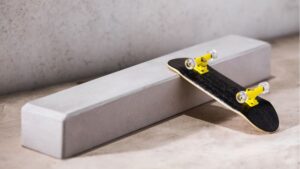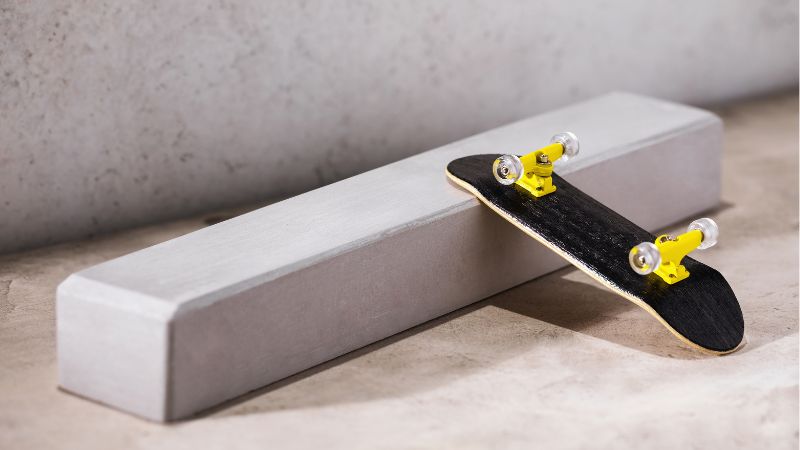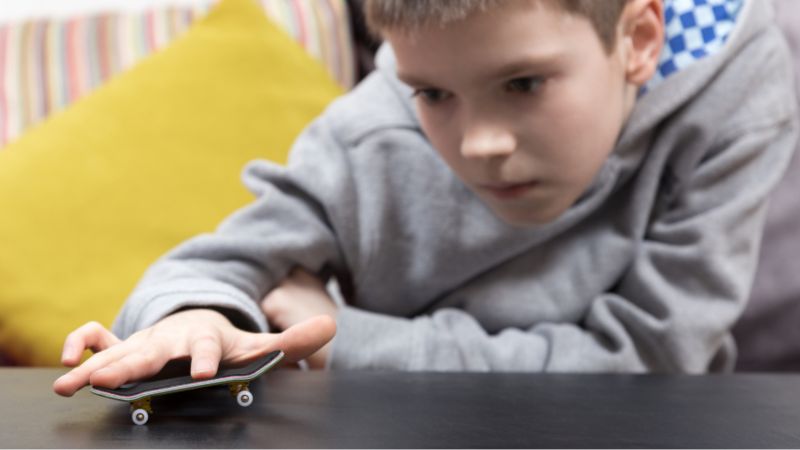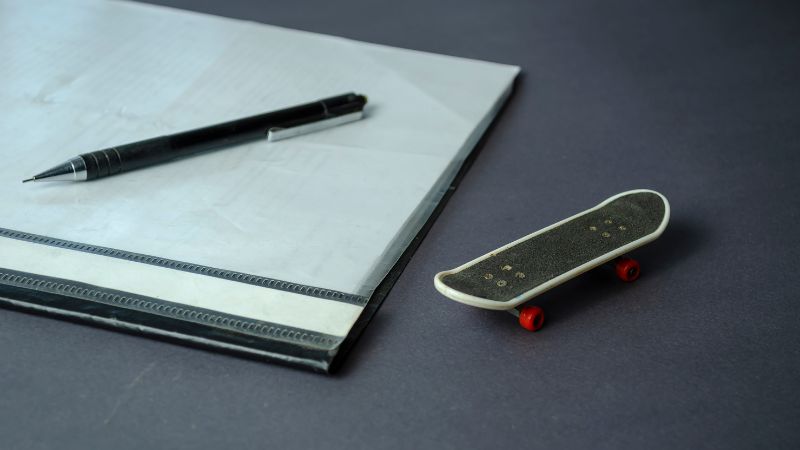
How to Make a Fingerboard Ramp? Easy Guide
Ever since I discovered fingerboarding, the scaled-down cousin of skateboarding, I’ve been hooked. There’s something truly mesmerizing about executing intricate tricks with just my fingers

Handboarding, also known as fingerboarding, has risen tremendously in popularity over the past decade. But along with the fun comes inherent risks that handboarding enthusiasts should keep in mind.
In this comprehensive guide, we’ll outline key safety tips and precautions to help fingerboarders stay injury-free and enjoy the hobby responsibly.
While hand boarding doesn’t involve the same high speeds and impacts as regular skateboarding, certain risks remain that should be considered:
Repeated finger flicking can lead to joint pain, tendonitis or sprains over time, especially when attempting complex tricks. Gripping the board tightly for maneuvers can also strain fingers.
Fingerboards or parts flying off during tricks pose a threat to eye injuries. Fingers flicking near the eyes is another hazard.
The small parts involved in hand boards pose a choking risk for younger kids if pieces become detached and swallowed.
Poor posture and repetitive finger/hand motions during extended sessions can result in muscle tightness or chronic issues like carpal tunnel syndrome.
Enthusiastically doing tricks without regard for surroundings can lead to collisions with objects or people, falls, etc. Lack of spatial awareness while handboarding is a safety issue.
Attempting tricks too high up without adjusting for landing risks falling and hitting one’s head on the ground or objects below. Stay low.
Falling with a handboard in your mouth can chip teeth. Keep boards away from face when doing tricks.
Keeping these common pitfalls in mind, following some general best practices will help minimize injury risk:
Wearing protective finger braces and pads helps absorb impact and strain on fingers attempting demanding tricks. Protective eyewear like sports goggles is also recommended.
Take short breaks every 20-30 minutes during handboarding sessions to rest fingers, hands, arms and eyes. Avoid marathon sessions without rest.
Hunching over a handboard for hours strains the back and neck. Be mindful to sit up straight and adjust your posture.
Stretching the hands and wrists before sessions helps warm up joints and tendons reducing strain. Yoga poses for wrists and forearms are ideal.
Resting forearms or wrists on a pillow or foam pad takes pressure off joints when handboarding extensively.
Drinking enough water prevents muscle cramping and fatigue that can lead to overuse injuries.
If fingers, hands or arms start feeling strained, stop and take a longer break. Don’t play through moderate pain as it may worsen.
Ensure the fingerboard is firmly gripped before attempting tricks to prevent it from flying out of hand into the face/eyes.
Clear the area around the handboarding zone to prevent collisions with objects. Have spotters if needed.
Use padded mats or soft surfaces under handboarding areas in case of falls. Avoid hard floors.
Special care should be taken to promote safety for younger handboarding enthusiasts:
Actively watch kids under 10 during handboarding to ensure proper technique, posture, and attentiveness. Don’t let them play unattended.
Show beginners how to brace the base of palms on the surface for stability rather than straining fingers and wrists. Reinforce often.
Younger kids should avoid advanced tricks. Begin with simple ramps and inclines to learn to balance.
Frequently check the tightness of all screws, bolts, and components on beginner boards. Replace immediately if loosening.
Mandate regular 10-minute breaks for young kids after 20 minutes of play at most. Their smaller hands tire faster.
Keep hand boarding sessions under an hour for children under 12. Increase gradually as their finger strength builds up.
If a child indicates fingers or wrists hurt during or after play, have them rest completely for a day or two to recover.
If younger siblings are around, remove any loose small parts after sessions where toddlers can reach them.
Show kids how to spot friends trying risky new tricks to assist if needed. Promotes attentiveness.
Ensure kids don’t attempt tricks from dangerous heights where falling could lead to serious injury. Stay low.
Some common poor hand boarding habits can exacerbate injury risks:
Bending the head and neck forward strains the spine. Sit upright.
Holding the board too tightly tenses muscles. Relax grip.
Overextending fingers to reach tricks hurts joints. Move the whole hand/wrist instead.
Letting the leg nervously bounce strains the core. Keep steady.
Avoid bending the wrist up or down sharply. Keep neutral.
Playing through moderate finger pain can cause lasting damage.
Trying to learn tricks too quickly with poor form leads to finger sprains. Build up gradually.
Doing tricks while walking or looking elsewhere raises injury risk. Stay focused.
Flicking the board forcefully and erratically raises the risk of losing control and collisions. Remain smooth.
Implementing proactive hand care strategies helps reduce the risk of repetitive strain:
Massaging fingers, hands, wrists, and forearms boosts circulation and loosens muscles.
Taking time to properly stretch hands and wrists keeps joints limber.
Simple finger stretches and exercises are done daily to guard against tightness.
Taking occasional full days off from handboarding allows recovery.
Icing fingers and wrists after sessions reduces inflammation that leads to injury.
Using padded grips on boards protects from vibration and shock.
Eating foods rich in bone & joint health nutrients keeps connective tissues resilient.
Always spend time before intensive sessions warming up hands to avoid straining cold muscles.
Using massage balls and rollers helps provide deep tissue relief to affected areas.
Consume turmeric, ginger, and fish oil supplements to fight inflammation-causing damage.
Besides physical safety, fingerboard enthusiasts must also take care to promote a safe, clean environment:
Keep trick charger cables neatly coiled and away from boards to avoid tripping hazards.
Stow loose items that could fall and be damaged during energetic handboarding.
Sweep the area first to prevent rolling over bits that could fling up.
Be conscious of handboarding noise levels to avoid irritating others nearby.
Responsibly discard old wheels, boards, and parts rather than littering or allowing access by unsupervised kids.
Don’t leave charging boards unattended to prevent overheating risks.
Abide by any public space restrictions in your community on allowable hand boarding areas.
Avoid damage to tables and surfaces by using protective pads underneath handboards.
Ensure indoor fingerboarding areas have proper ventilation if using spray adhesives.
Wash hands thoroughly before eating after handling boards, wheels, lubricants, etc.
Avoid using boards outdoors on wet, snowy, or excessively windy days when you may lose control.
While most hand boarding pains subside with rest, seek medical advice if experiencing:
Don’t try to play through moderate to severe hand pain as further damage may occur. Seeking prompt medical assessment helps diagnose the severity and recommended treatment.
It’s easy to become complacent about safety when hand boarding feels so simple and routine. But staying vigilant is key:
Remaining thoughtful and proactive day in and day out keeps safety top of mind.
As leaders and influencers, professional hand boarders play a key role in cultivating an overall culture of safety and responsibility:
Pros must emphasize safety when interviewed. Encourage wearing protection, responsible trick progression, speaking up about pain, etc.
Elite fingerboarders lead by example – wearing protection, taping wrists, doing wrist exercises, etc.
Veterans calling out or constructively criticizing young pros taking excessive risks to progress too fast.
Competition organizers mandate minimum safety gear, on-site medic support, proper warm-ups, etc.
YouTube/TikTok stars using content warnings for videos, avoiding showcasing reckless behavior.
Hand boarding delivers immense fun and satisfaction with the right safety awareness. While risks remain, following sensible precautions, listening to your body, and leveraging protective gear greatly minimize injury potential.
Safety-conscious habits ensure many more years of happy handboarding ahead. So get out there and keep pushing the sport forward – carefully and responsibly!


Ever since I discovered fingerboarding, the scaled-down cousin of skateboarding, I’ve been hooked. There’s something truly mesmerizing about executing intricate tricks with just my fingers

Skateboarding and fingerboard tricks are always fun and worth learning. With so many tricks out there, it can be hard to choose which one to

Hey there fellow fingerboard enthusiasts! If you’re like me, you’re always looking for ways to personalize and improve your fingerboard setup. One fantastic way to

Hand boarding, also known as fingerboarding, has exploded in popularity over the past decade, becoming a global phenomenon and community. For the uninitiated, hand boarding

Ever since I discovered fingerboarding, the scaled-down cousin of skateboarding, I’ve been hooked. There’s something truly mesmerizing about executing intricate tricks with just my fingers

Skateboarding and fingerboard tricks are always fun and worth learning. With so many tricks out there, it can be hard to choose which one to

Hey there fellow fingerboard enthusiasts! If you’re like me, you’re always looking for ways to personalize and improve your fingerboard setup. One fantastic way to

Handboarding, also known as fingerboarding, has risen tremendously in popularity over the past decade. But along with the fun comes inherent risks that handboarding enthusiasts
Copyright © 2024 surfxhandboard. All Rights Reserved.